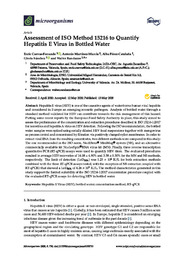Please use this identifier to cite or link to this item:
https://hdl.handle.net/11000/35091Full metadata record
| DC Field | Value | Language |
|---|---|---|
| dc.contributor.author | Cuevas, Enric | - |
| dc.contributor.author | Martinez-Murcia, Antonio | - |
| dc.contributor.author | Pérez-Cataluña, Alba | - |
| dc.contributor.author | Sánchez, Gloria | - |
| dc.contributor.author | RANDAZZO, Walter | - |
| dc.contributor.other | Departamentos de la UMH::Producción Vegetal y Microbiología | es_ES |
| dc.date.accessioned | 2025-01-21T12:02:44Z | - |
| dc.date.available | 2025-01-21T12:02:44Z | - |
| dc.date.created | 2020-05-13 | - |
| dc.identifier.citation | Microorganisms 2020, 8(5), 730 | es_ES |
| dc.identifier.issn | 2076-2607 | - |
| dc.identifier.uri | https://hdl.handle.net/11000/35091 | - |
| dc.description.abstract | Hepatitis E virus (HEV) is one of the causative agents of water-borne human viral hepatitis and considered in Europe an emerging zoonotic pathogen. Analysis of bottled water through a standard method validated for HEV can contribute towards the risk management of this hazard. Putting some recent reports by the European Food Safety Authority in place, this study aimed to assess the performance of the concentration and extraction procedures described in ISO 15216-1:2017 for norovirus and hepatitis A virus on HEV detection. Following the ISO recommendation, the bottled water samples were spiked using serially diluted HEV fecal suspensions together with mengovirus as process control and concentrated by filtration via positively charged nylon membranes. In order to extract viral RNA from the resulting concentrates, two different methods were compared in this study: The one recommended in the ISO norm, NucliSens® MiniMag® system (NS), and an alternative commercially available kit NucleoSpin®RNA virus kit (MN). Finally, three reverse transcription quantitative PCR (RT-qPCR) assays were used to quantify HEV titers. The evaluated procedures resulted in average HEV recoveries of 14.08 ± 4.90% and 3.58 ± 0.30% for the MN and NS methods, respectively. The limit of detection (LoD95%) was 1.25 × 104 IU/L for both extraction methods combined with the three RT-qPCR assays tested, with the exception of NS extraction coupled with RT-qPCR1 that showed a LoD95% of 4.26 × 103 IU/L. The method characteristics generated in this study support the limited suitability of the ISO 15216-1:2017 concentration procedure coupled with the evaluated RT-qPCR assays for detecting HEV in bottled water | es_ES |
| dc.format | application/pdf | es_ES |
| dc.format.extent | 8 | es_ES |
| dc.language.iso | eng | es_ES |
| dc.publisher | MDPI | es_ES |
| dc.rights | info:eu-repo/semantics/openAccess | es_ES |
| dc.rights | Attribution-NonCommercial-NoDerivatives 4.0 Internacional | * |
| dc.rights.uri | http://creativecommons.org/licenses/by-nc-nd/4.0/ | * |
| dc.subject | Hepatitis E Virus (HEV) | es_ES |
| dc.subject | Bottled water | es_ES |
| dc.subject | Concentration method | es_ES |
| dc.subject | RT-qPCR | es_ES |
| dc.title | Assessment of ISO Method 15216 to Quantify Hepatitis E Virus in Bottled Water | es_ES |
| dc.type | info:eu-repo/semantics/article | es_ES |
| dc.relation.publisherversion | https://doi.org/10.3390/microorganisms8050730 | es_ES |

View/Open:
Assessment of ISO Method 15216 to Quantify Hepatitis E Virus in Bottled Water.pdf
736,81 kB
Adobe PDF
Share:
.png)
